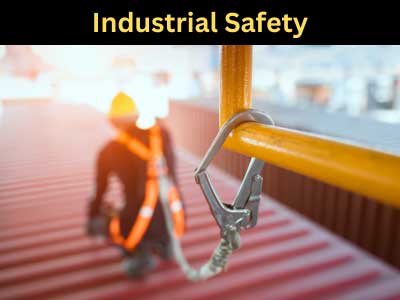Key Takeaway
Industrial safety risks are hazards that can cause injury, illness, or damage in industrial settings. These risks include slips and falls, fires, explosions, and exposure to toxic substances. Identifying these risks is crucial for implementing effective safety measures.
To manage industrial safety risks, companies conduct risk assessments to identify potential hazards. They use techniques like job safety analysis and hazard identification. Mitigation strategies include providing proper training, using personal protective equipment (PPE), and implementing safety protocols. Regular safety audits and inspections help ensure compliance and identify areas for improvement. By managing safety risks effectively, industries can protect their workers, reduce accidents, and maintain a safe work environment.
Defining Industrial Safety Risk in Manufacturing
Industrial safety risk refers to the potential hazards that workers face in industrial environments, especially in manufacturing settings. These risks can stem from various sources, such as heavy machinery, hazardous materials, electrical systems, or physical processes. In manufacturing, the fast pace and complexity of operations increase the likelihood of accidents if proper safety measures aren’t followed.
Identifying safety risks early is crucial for preventing incidents that can cause harm to workers, halt production, and damage equipment. Risks range from physical injuries like slips and falls to exposure to toxic chemicals, noise pollution, and even electrical hazards. Understanding these risks allows companies to create specific safety protocols that help reduce accidents and maintain smooth operations.

Common Types of Safety Risks in Industrial Environments
Industrial environments are filled with various safety risks that need careful management. Some of the most common types include physical risks, such as slips, trips, and falls, often caused by poor housekeeping or improperly maintained floors. Another major risk is the improper use of heavy machinery, where workers can get injured due to mechanical failures or inadequate training. Handling hazardous materials also presents risks, as exposure to chemicals or toxic substances can lead to long-term health issues.
Electrical risks are significant in manufacturing settings, where faulty wiring, exposed circuits, or ungrounded equipment can lead to electrocution or fires. Noise pollution is another hidden risk, as prolonged exposure to high decibel levels can result in hearing damage. Ergonomic risks, such as repetitive strain injuries from improper workstation setups, can also accumulate over time, affecting worker health and productivity. By recognizing these common risks, companies can take proactive measures to safeguard their workers.
The Role of Risk Assessments in Preventing Accidents
Risk assessments play a critical role in preventing accidents in industrial settings. These assessments involve identifying potential hazards, evaluating the likelihood and severity of those hazards, and implementing controls to mitigate or eliminate them. A comprehensive risk assessment looks at all aspects of the work environment, including equipment, processes, materials, and even employee behavior.
The process typically begins by gathering data on past incidents, observing current operations, and consulting with employees who work directly with hazardous equipment or materials. From there, risks are ranked based on their potential impact and likelihood. For example, tasks involving heavy machinery might be flagged as high-risk, requiring more rigorous safety protocols like machine guarding, regular maintenance, and employee training. Once risks are identified, control measures—such as engineering solutions, administrative changes, or personal protective equipment (PPE)—are implemented to prevent accidents.
Regular reviews of risk assessments ensure that any new risks introduced by changes in processes, materials, or equipment are promptly addressed, creating a safer workplace overall.
How Technology Can Minimize Safety Risks
Advancements in technology have revolutionized how industrial safety risks are managed. Automation and robotics, for example, can replace manual tasks that expose workers to dangerous conditions. In manufacturing environments, automated systems reduce the need for workers to interact with heavy machinery, hazardous chemicals, or dangerous production lines. This significantly decreases the chances of workplace accidents.
Wearable technology has also become a key tool in reducing industrial safety risks. Devices like smart helmets or wristbands monitor workers’ physical condition, alerting them and their supervisors to potential health risks, such as fatigue or exposure to harmful substances. Real-time data from these devices can be analyzed to spot patterns that indicate unsafe working conditions, allowing for immediate interventions.
Additionally, predictive maintenance tools can help identify equipment failures before they occur, preventing accidents that arise from malfunctioning machinery. By embracing these technologies, companies can not only enhance safety but also improve efficiency by reducing downtime and accident-related delays.
Implementing Safety Protocols to Address Risk Factors
Implementing effective safety protocols is essential for addressing the various risk factors present in industrial environments. Safety protocols provide a structured approach to managing risks, ensuring that all employees are aware of the procedures they must follow to stay safe. One of the first steps is to develop clear guidelines that address specific hazards, such as the proper handling of machinery, the use of PPE, and emergency response procedures in case of accidents.
Safety training is also a critical part of implementing protocols. Employees need to be regularly trained on how to recognize potential hazards and what actions to take to minimize risks. For example, workers handling toxic chemicals must understand how to store and dispose of them properly, while those operating heavy equipment need training in safe operating procedures.
Regular safety inspections and audits ensure that protocols are followed consistently. These inspections help identify any gaps in the safety measures and allow for continuous improvement. Companies that maintain strict adherence to safety protocols not only protect their workers but also reduce the likelihood of costly accidents, fines, and production downtime.
Conclusion
Managing industrial safety risks is a continuous process that requires a proactive approach. By defining potential hazards, conducting regular risk assessments, leveraging technology, and implementing comprehensive safety protocols, companies can create safer working environments. These efforts not only protect workers but also lead to improved operational efficiency and compliance with industry standards. Safety should be an ongoing priority, with continuous monitoring, training, and updating of procedures to adapt to new risks. By focusing on managing safety risks effectively, companies can ensure the well-being of their employees while maintaining a productive and compliant workplace.
